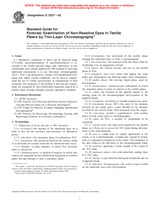Potřebujeme váš souhlas k využití jednotlivých dat, aby se vám mimo jiné mohly ukazovat informace týkající se vašich zájmů. Souhlas udělíte kliknutím na tlačítko „OK“.
ASTM E2227-02
Standard Guide for Forensic Examination of Non-Reactive Dyes in Textile Fibers by Thin-Layer Chromatography
Automaticky přeložený název:
Standardní Příručka pro forenzní vyšetření Non - reaktivních barviv v textilní vlákna pomocí tenké vrstvě
NORMA vydána dne 10.8.2002
Informace o normě:
Označení normy: ASTM E2227-02
Poznámka: NEPLATNÁ
Datum vydání normy: 10.8.2002
Kód zboží: NS-44722
Počet stran: 6
Přibližná hmotnost: 18 g (0.04 liber)
Země: Americká technická norma
Kategorie: Technické normy ASTM
Anotace textu normy ASTM E2227-02 :
Keywords:
fibers, forensic science, thin-layer chromatography, ICS Number Code 71.040.50 (Physicochemical methods of analysis)
Doplňující informace
| Significance and Use | ||||||||
|
Forensic analysis of fiber colorants using TLC should be considered for single fiber comparisons only when it is not possible to discriminate between the fibers of interest using other techniques, such as comparison microscopy (brightfield and fluorescence) and microspectrophotometry in the visible range. The extraction procedures carried out prior to TLC analysis can provide useful information about dye classification. TLC can provide useful qualitative information about dye components. Similar colors made up of different dye components can be differentiated using this technique. The application of TLC may serve to discriminate between fibers, or it may confirm their similarity. TLC may be prohibitively difficult or undesirable in some circumstances. Short lengths of fibers or pale colored fibers may not have an adequate concentration of colorant present to be examined, dye extraction from some fibers may be impossible. The desire to preserve evidence for possible analysis by another examiner may preclude removing the color for analysis. Dye from the known material should first be characterized and eluent systems evaluated to achieve optimum separation of the extract. Dye is then extracted from single known and questioned fibers, using an equivalent amount of material. The development of each individual TLC plate will show some variability as a result of the coating and conditioning of the plate, solvent condition, and temperature. It is important to evaluate the performance of each TLC plate by spotting known materials along with the questioned samples. See Ref (16). Examples for the preparation of Standard dye mixtures are given in Appendix X1. |
||||||||
| 1. Scope | ||||||||
|
1.1 Metameric coloration of fibers can be detected using UV/visible spectrophotometry. If spectrophotometry is restricted to the visible spectral range only, differences in dye components may remain undetected. One method of detecting additional components is to use thin-layer chromatography (TLC). TLC is an inexpensive, simple, well-documented technique that, under certain conditions, can be used to complement the use of visible spectroscopy in comparisons of fiber colorants. The principle of the method is that the dye components are separated by their differential migration caused by a mobile phase flowing through a porous, adsorptive medium. |
||||||||
| 2. Referenced Documents | ||||||||
|
Doporučujeme:
Aktualizace technických norem
Chcete mít jistotu, že používáte pouze platné technické normy?
Nabízíme Vám řešení, které Vám zajistí měsíční přehled o aktuálnosti norem, které používáte.
Chcete vědět více informací? Podívejte se na tuto stránku.




 Cookies
Cookies
